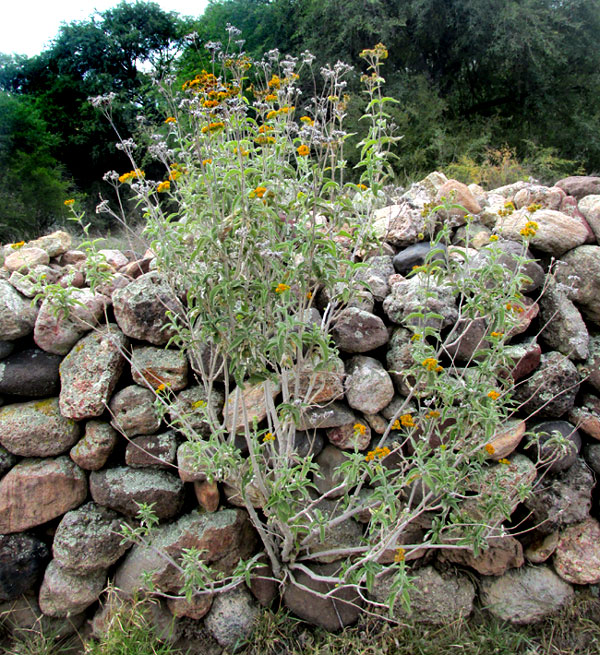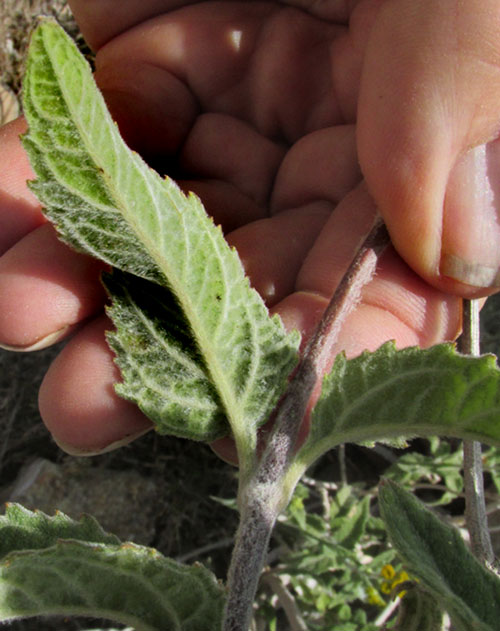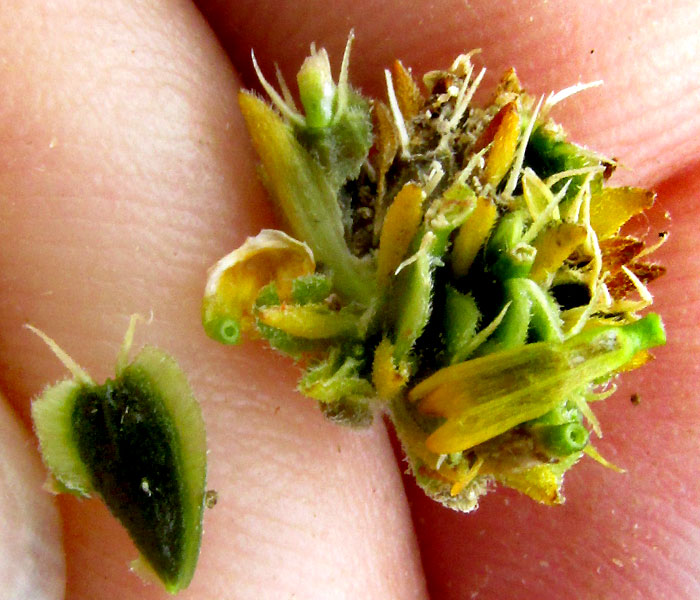Excerpts from Jim Conrad's
Naturalist Newsletter
entry dated July 13, 2022, issued from near Tequisquiapan, elevation about 1,900m (6200 ft), N20.565°, W99.890°, Querétaro state, MÉXICO
VERBESINA SERRATA

I've been waiting for the above species to flower, to identify it, because it's unusual. First it's a woody shrub still holding last year's fruiting heads, but it's a member of the Composite or Aster Family, the Asteraceae, in which the vast majority of species are herbaceous. Second, here the rainy season normally comes in mid May or so but this year there's no sign of it, so the landscape is very parched looking (except for the deep rooted mesquites in the background), but these plants are thriving. Third, with their white-fuzzy leaves, shown below, and bright yellow flowers, they're quite handsome.

The heavy coating of white hairs and its leaves' tendency to fold together and slightly twist should lessen water loss and protect it from our intense sunlight.

The heavy woolliness on the flowering heads is noteworthy, as well as the rounded tips of the green bracts, or phyllaries, forming the bowl-like involucres holding the clusters of closely packed, orange-yellow disc florets. The surprise is that there's no hint of ray florets, the flat, petal-like flowers arising at the periphery of many composite flowering heads. Those species who never produce ray florets, like the bonesets, eupatoriums, baccharises and such, normally produce flowers that are white, pink or blue, but not yellowish. This plant just doesn't fit the mold of anything.

With my old eyes I can't see what I've exposed when breaking open small capitula such as the above; only when the picture is on the screen can I see if a mess has been made. The above is a mess but at least you can see a mature cypsela-type fruit at the lower left, flattened, with papery wings along the sides and topped with two weak, needlelike "awns." In the disheveled capitulum at the right you can better see that the cypselae are hairy. Also, between the cypselae there are yellowish, scoop-shaped scale-like paleae. These are all critical features to know for figuring out this plant's identity.
While "doing the botany," the surprises just kept coming. First, it's a member of the big genus Verbesina, often known to those who notice wildflowers as wingstems, because many of the species bear green, vertical "wings" on their stems, though this species doesn't. Verbesina species are mostly tropical and subtropical and native only to the Americas. North America is home to about 16 species while about 25 turn up just in our semiarid, upland central Mexican region known as the Bajío. But, the main surprise was that all the Verbesina species I ever knew bear petal-like ray florets along their capitula margins, while this one has none. This is a nonconformist Verbesina.
Among our local area's 25 Verbesina species, our plant is distinguished by producing leaves opposite one another on the stem instead of alternating them, the stem bearing no wings, the plants having woody bases, their leaves being broadest toward the base and slowly tapering to the tip, having sawtoothed leaf margins, and by producing no ray flowers.
Those features take us exactly to VERBESINA SERRATA, with no English name but sometimes in Spanish called Vara Blanca or "White Rod." It's idiosyncratic appearance may be explained by its being endemic just to the semiarid spineforest/mesquite habitat, at elevations between 1740 to 2750m (5700-9050m), in west-central upland Mexico, from Zacatecas and Guanajuato states south through here to Jalisco. In other words, it's adapted to a very specific semi-arid environment at a fairly limited range of elevations, so no wonder it's surviving during the current drought. Its genes have recorded all this before, and made provisions.
Interestingly, sometimes one or more Verbesina serrata capitula do produce regular Verbesina-type, petal-like ray florets. Apparently ray-floret-producing genes from an ancestral species have been retained by our species, but they're "turned off," perhaps to save water by exposing less surface area, and sometimes the genes halfway get turned on.
Little information is available about Verbesina serrata, though Ricardo Soler Mora in his undated, government-website-scattered-about "Capítulo 4. Usos de la Biodiversidad," mentions that it's a good nectar producer, and that somehow it's been used traditionally to treat hemorrhoids.